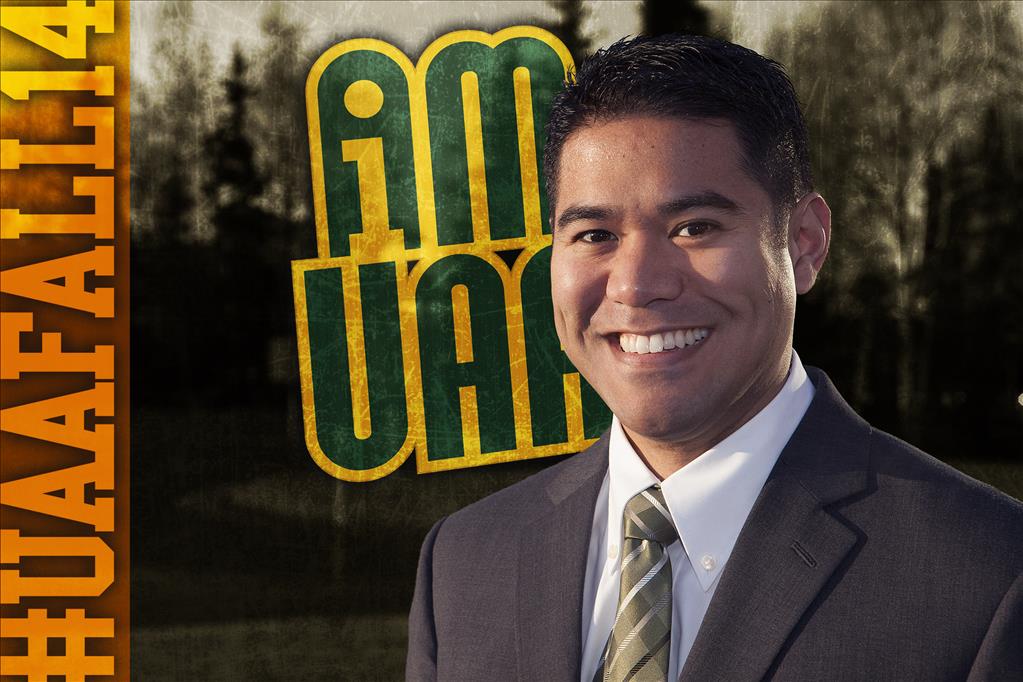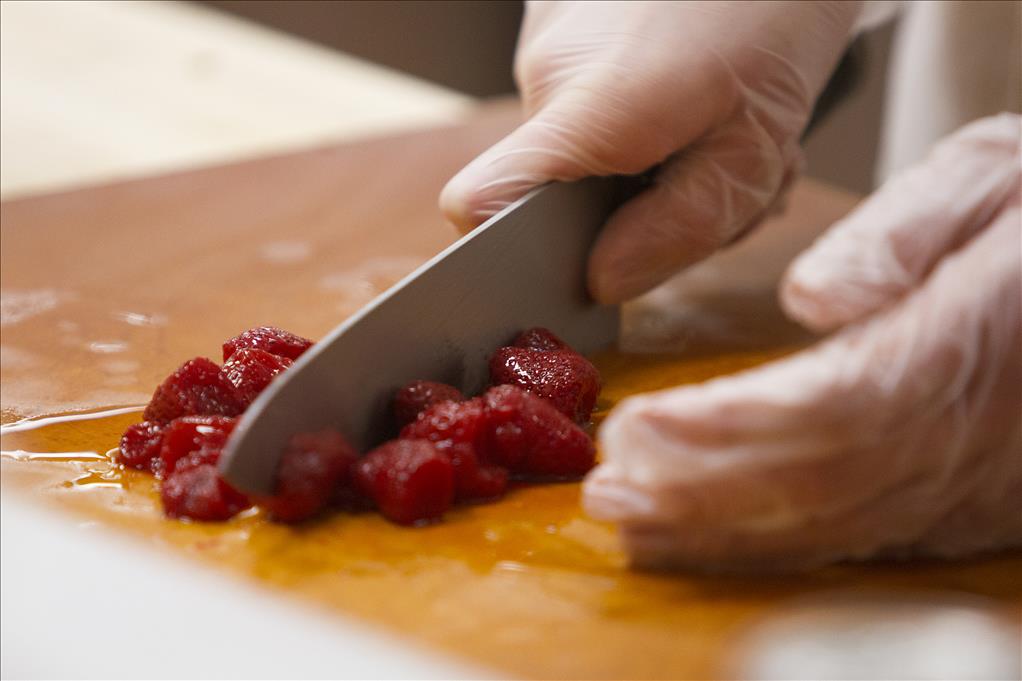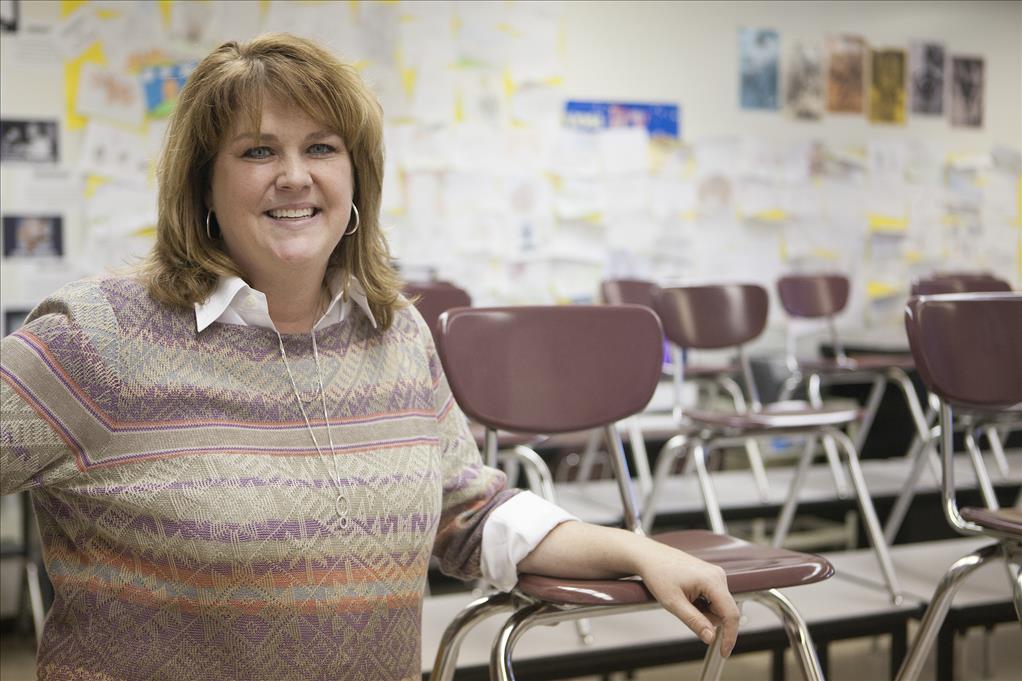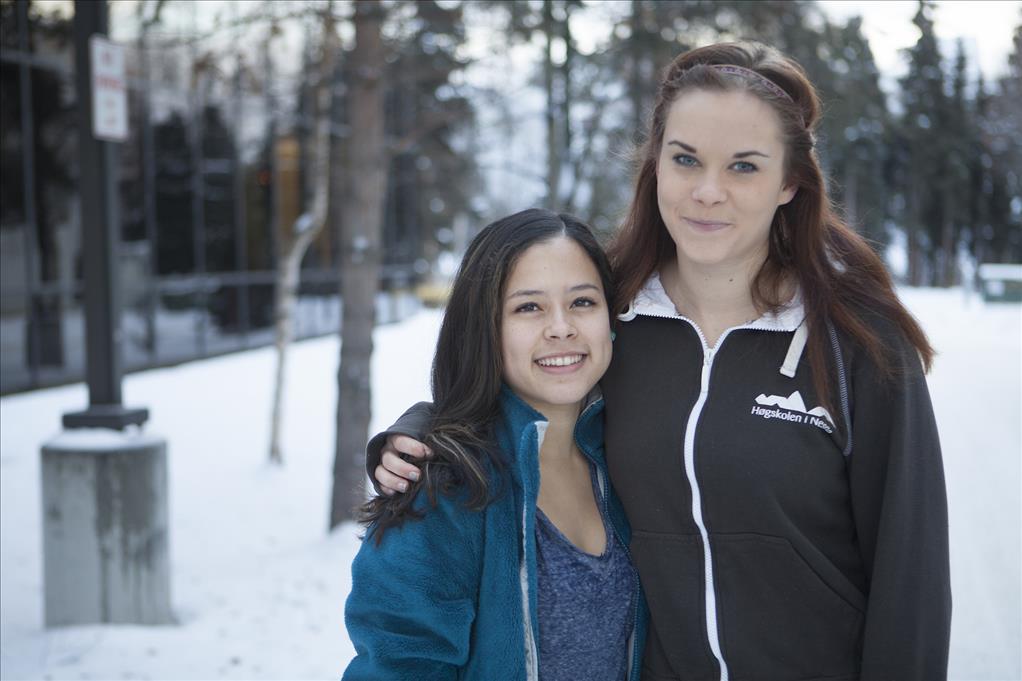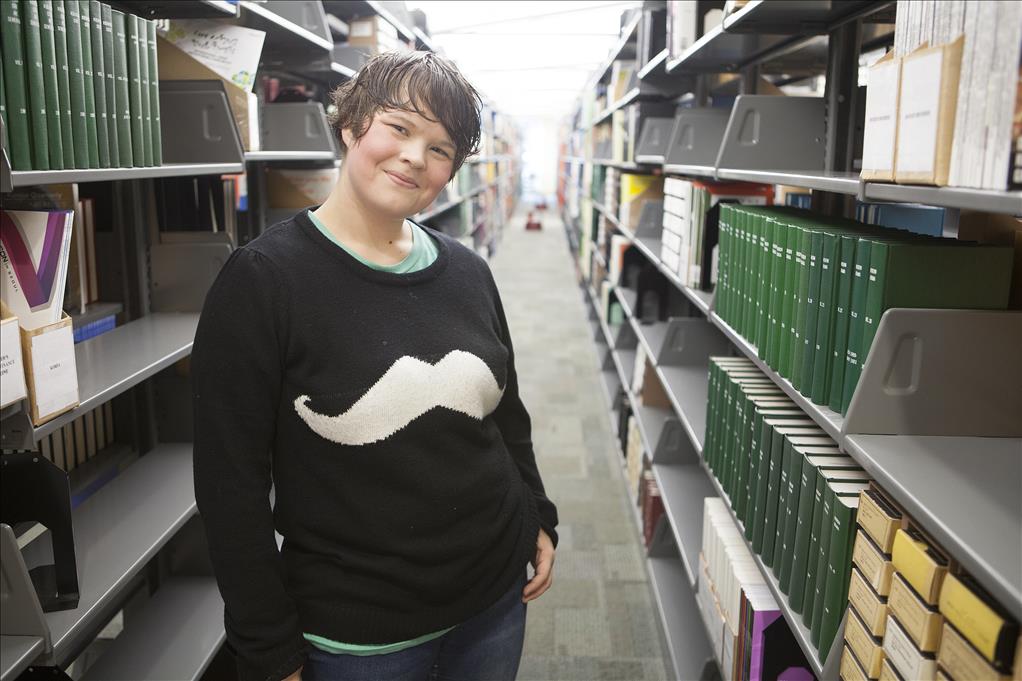Growing support for Alaska Native nursing students
by Tracy Kalytiak |
Seventeen years ago, after Stephanie Sanderlin first moved away from home to go to college in Iowa, a police officer ticketed her for turning at a traffic signal while the light was red.

Stephanie Sanderlin is one of RRANN's two student success facilitators. She grew up in Dillingham and now helps Alaska Native students succeed through the RRANN program at UAA. (Photo by Philip Hall/University of Alaska Anchorage)
"I didn't grow up with stoplights, didn't have real-world experience with them," said Sanderlin, who grew up in comparatively tiny Dillingham. "No one had told me I could only turn right at the light, not left."
Leaving a rural Alaska home to go to college is an experience and understanding Sanderlin brings to her job as a student success facilitator for UAA School of Nursing's Recruitment and Retention of Alaska Natives in Nursing program. RRANN, as part of Alaska Native Heritage Month, is celebrating its 15th anniversary at a free public event from 5-7 p.m., Wednesday, Nov. 12, at the Alaska Heritage Museum, which is located in the Wells Fargo building at 301 W. Northern Lights Blvd. RRANN's other student success facilitator, Rebecca Dreier, coordinated the event.
"The first 'R' in RRANN is 'recruitment' but it should be 'relationships,'" Sanderlin said. "We want students to have a place they belong. We connect as people before we do anything. I'm not their academic advisor, not their professor. I tell them, 'I'm your auntie at school. A big part of my job is to be here for you and to support you."
'There were no Alaska Native RNs'
Dr. Tina DeLapp founded RRANN in 1998, using federal grant money to launch a program for recruiting and mentoring Alaska Natives and American Indians aspiring to become nurses.
The idea first germinated nearly three decades before, after DeLapp moved to Alaska with her new husband-a U.S. Public Health Service engineer-and started working as a registered nurse at Bethel's hospital.
"One of the first things I noticed was that there were no Alaska Native RNs, despite the fact that the hospital clients were almost 100 percent Alaska Native," she said. "There were two licensed practical nurses of Alaska Native origin and all of the nursing assistants were Alaska Native, but none of the professional staff-nurses, physicians, dentists, pharmacists, social workers-were Alaska Native. Even though I noticed the lack of Native providers, I don't think I really thought it was any big deal."

Stephanie Sanderlin's office at UAA's Health Science Building provides an oasis of comfort and familiarity to students in the RRANN program. (Photo by Philip Hall/University of Alaska Anchorage)
DeLapp learned otherwise. Not knowing the culture of the people coming in for care diminishes the ability of a doctor or nurse to administer the most effective care possible, she said.
One of the things DeLapp learned in Bethel was that Yupik patients often said 'yes' by raising their eyebrows, without speaking. Health care providers who didn't know this might not realize a patient needs help.
"If you asked someone if they were in pain and they put their eyebrows up, you could tell them, 'Let me see what I can do,'" she said.
DeLapp also realized there are many Alaska Native cultures and many nuances within each of those cultures.
"I remember being totally shocked when I asked one of the nursing assistants to explain to a patient who spoke only Yupik that they were supposed to take one pill twice a day," DeLapp said. "She said, 'I can't. She speaks a different dialect.' There were lots of issues like that."
Helping nursing students find footing
Eight years later, DeLapp joined the nursing faculty in Anchorage and saw that only an occasional Alaska Native student completed the program.
"The idea that we ought to be doing something was pretty clear to me by the time I'd been teaching in the School of Nursing for four or five years," DeLapp said. "I would get a student from rural Alaska in my pathophysiology class who was confident, enthusiastic and interested in nursing, from a tiny school where she was the only person in the upper half of her graduating class. In that sort of environment, with just four or five classmates, they're going to look confused if they don't understand something. The teacher will ask what they can help with. They don't have to learn to ask for help."
In nursing school, DeLapp said, that student would enroll in an 80-student pathophysiology class and not know how to ask for help. She'd come to campus and live in a place with so many more people than at home. She wouldn't know anybody and get unbearably lonely.
"At three weeks or six weeks, she'd give up and go home," DeLapp said, "but she wouldn't know the bureaucracy, wouldn't know that if you don't withdraw, you get a transcript full of F's and have to start repaying student loans in exchange for getting your confidence shattered. It took nearly 20 more years before I was in a position to do anything about it, which is when RRANN started."
Getting to students and keeping them connected
Two hundred twenty RRANN students have graduated since the program's inception, including next month's 16 RRANN graduates.
"It's our all-time record," Sanderlin said of the size of the RRANN group graduating in December. "We're very excited."
Dr. Jacqueline Pflaum, RRANN's program director, says RRANN offers classes in Anchorage and videoconferenced classes at 13 distance-learning sites throughout Alaska, including Bethel, Dillingham, Fairbanks, Homer, Juneau, Kenai, Ketchikan, Kodiak, Kotzebue, Mat-Su, Nome, Sitka and Valdez.
Rebecca Dreier conducts outreach for RRANN by traveling to schools throughout rural Alaska to educate young people about nursing and other health care occupations. Dreier flew to Nome, Savoonga and Stebbins earlier this year and she also attends career fairs and conferences-including the First Alaskans Institute Elders & Youth Conference held before the Alaska Federation of Natives Convention.
Free tutoring and the help Dreier and Sanderlin offer provide the core of the program: critical support for students, Pflaum said.
"The tutoring program doesn't only tutor Alaska Native students, but tutors all nursing students, which is very helpful," she explained. "Those getting tutoring have an 85 percent pass rate."
Alaska Native students, particularly those coming from rural schools, face challenges. Their rural schools may not have offered the same academic opportunities as larger, more urban schools, and so they require some remedial help. Some students speak English as a second language.
"Keeping them motivated and supported is really critical," Pflaum said. "The things that help them stay are getting to them early, getting them connected to a nursing advisor and success facilitator in RRANN. Once they get out of the prerequisite sequence and into the clinical sequence, they're almost the same percentage likely to graduate as any other nursing student."
Louise Deray Kangas, 26, is one of those RRANN students who emerged with a bachelor's degree and immediately found a career. Originally from Ruby, Kangas moved to Fairbanks in the fourth grade. She later attended UAA's distance-learning nursing classes there before moving to Anchorage to continue her studies.
After graduation, she worked for the Alaska Native Medical Center in an internal medicine/telemetry unit, transferred to a "float" nursing position, and then, in January, moved to Yakima, Wash., to work in a local intensive care unit. She plans to return to Fairbanks and start working on a master's degree as a UAA distance-learning student, to move closer to her goal of becoming a family nurse practitioner.
Her plan after graduating with that master's degree?
"I want to go back home," she said. "I miss my family. I want to reside in Alaska and use my role as a nurse practitioner to hopefully travel to various villages to provide more accessible care."
Feeling at home
Sanderlin, daughter of a commercial fisherman and a nurse who worked at the Dillingham hospital, greets incoming RRANN students and makes sure they know where to get their green UAA student scrubs, lab coats, stethoscopes, nursing watches and textbooks.
Her office offers a warm visual embrace for each student who walks in. Sanderlin says the office decor is "outside in."
One wall features maps of Alaska, adorned with a tiny kuspuk and a couple of balloon-like ptarmigan crops-puviaq-inflated and painstakingly knotted by Sanderlin's craftsman father: "He wasn't a professional, but I would rather my dad pull a splinter out of my finger because my mom's fast but my dad's careful."
Another wall features a large photo of blueberries, another photo of salmon strips, and a neat array of student scrubs hung on a low rod. She keeps pilot bread and peanut butter in a drawer decorated with festive salmon figurines.
Sanderlin tries to understand what the students encounter in their nursing classes. She attended pathophysiology classes because she'd heard about how rigorous they are.
"I was curious," she said. "I attended it to see how it was hard and how I could help students going through it. I read a little bit in the textbook and went to class. When I walked out of there, I was pretty sure we needed to buy more smart pens and make sure students had access to the class PowerPoint presentations. It was a fast-paced, intense environment. Taking notes on a regular notepad was almost impossible. You needed to make sure you had the PowerPoint outline already printed out."
Sanderlin creates community not only in her office, but with monthly potluck gatherings and guest and student speakers. She usually prepares a dish with fish caught on her family's subsistence site in Dillingham, as well as other subsistence foods. There are door prizes: Amazon gift cards, Fred Meyer gift cards, Native arts and crafts, a can of salmon. She also helps create community online using RRANN's Kijik newsletter and its Facebook page.
"Online is how people connect these days," she said. "It's one of the main ways people get to know each other."
The Facebook page contains a mix of items Dreier and Sanderlin post: news stories about Ebola and about people doing henna tattoos on the heads of cancer patients who had lost their hair during chemotherapy mingle with inspiring stories-Chevak girls winning a prestigious full-ride scholarship- and useful tips, like a post about job fairs and this post from a nurse to all students involved in clinicals (supervised training opportunities at local clinics and hospitals): "If you clean your stethoscope with a bleach wipe after using it on a patient...let it dry before you put it around your neck. Even small amounts of liquid bleach can ruin a scrub top."
The student success facilitators also help students connect with resources: getting student scrubs or textbooks if their scholarship money hasn't yet arrived, for example. People who want to help RRANN students can visit the program's wishlist on Amazon and buy books and other items students need. "Gift cards to Fred Meyer, Target, Tesoro and other stores are so appreciated by students and can often help them out of tough situations," Sanderlin said.
Students email the success facilitators, post to the Facebook page, or simply drop by if they need help or want to talk.
"I have one who shows up every Monday, mid afternoon," Sanderlin said. "You can set your watch to it. We use a few Yupik words, eat candy out of my candy dish. She calls it her therapy visit. I'm not a therapist-I just give her a little vacation. In my office she can be herself, have a break. It takes me back to the coffee table at my mom's house. That's how we remain connected. That's how we remain motivated, and one way we maintain an identity."
Written by Tracy Kalytiak, UAA Office of University Advancement
 "Growing support for Alaska Native nursing students" is licensed under a Creative Commons Attribution-NonCommercial 4.0 International License.
"Growing support for Alaska Native nursing students" is licensed under a Creative Commons Attribution-NonCommercial 4.0 International License.










